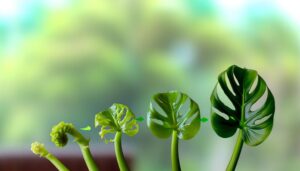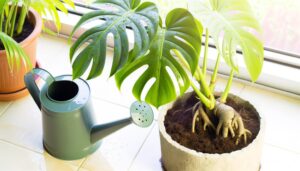Monstera Albo Wet Stick Propagation
To propagate Monstera Albo using wet sticks, select cuttings with healthy nodes and aerial roots. Use sterilized tools to make clean cuts and apply rooting hormone.
Maintain high humidity (70-80%) and keep the temperature between 75-85°F. Place cuttings in a mix of sphagnum moss and perlite, ensuring they receive bright, indirect light.
Regularly monitor for root development and signs of rot. Once roots form, transplant to a well-draining soil mix.
Proper care will increase your success rate, with each step playing a critical role in achieving strong, healthy growth. Exploring further will give you even more insights.
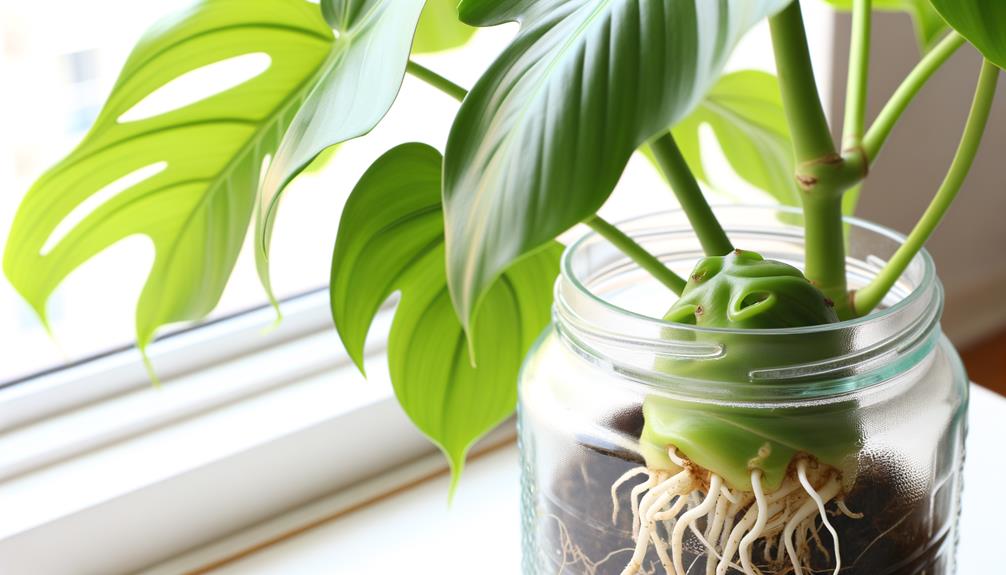
Key Takeaways
- Ensure the wet stick has a healthy node with aerial roots for successful propagation.
- Maintain high humidity levels (60-80%) and moderate air circulation.
- Use a sharp, sterilized blade to make clean cuts on the cuttings.
- Provide bright, indirect light for 6-8 hours daily to promote growth.
- Monitor regularly for root development and signs of disease or decay.
Understanding Wet Sticks
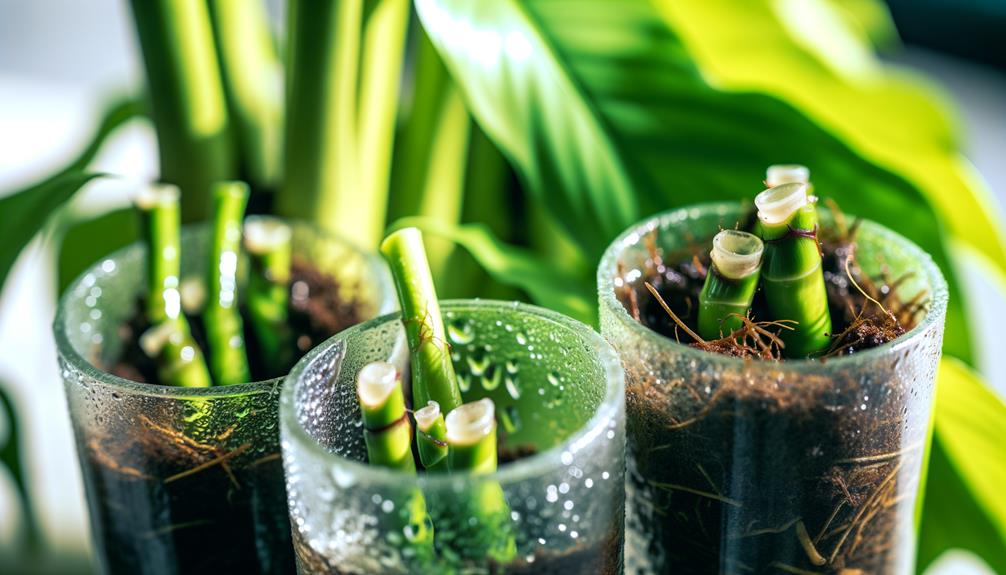
When propagating Monstera Albo, wet sticks—sections of the plant stem that include at least one node—serve as critical components for successful root development. You need to ensure the wet stick has a healthy node, as this is where roots and new growth will emerge.
The node, a small bump on the stem, contains meristematic tissue capable of producing roots and shoots. Make sure to maintain high humidity around the wet stick to encourage root formation. Submerge the node in water or place it in a moist growing medium, like sphagnum moss, to keep it hydrated.
Monitor the wet stick closely for signs of root growth, typically appearing within a few weeks under ideal conditions.
Choosing Healthy Cuttings
When selecting cuttings for Monstera Albo propagation, you should focus on specimens with well-developed aerial roots. These roots enhance the plant's ability to absorb moisture and nutrients.
Confirm the cuttings are free from signs of disease, such as discoloration or soft spots, to prevent the spread of pathogens. Healthy cuttings will increase your chances of successful propagation and robust plant growth.
Check for Aerial Roots
An essential step in selecting a healthy Monstera Albo cutting involves examining the presence and condition of aerial roots, as these roots are crucial for successful propagation. Aerial roots, which grow from nodes, help the cutting absorb water and nutrients more efficiently.
To make sure your cutting thrives, check for the following:
- Presence of Aerial Roots: Look for roots emerging from the nodes.
- Root Condition: Confirm the roots are firm and not mushy, indicating they're healthy.
- Root Length: Ideal aerial roots should be at least 1-2 inches long.
- Root Color: Healthy roots are usually white or light brown, not dark or blackened.
Inspect for Disease Signs
Inspect your Monstera Albo cuttings for diseases by carefully examining the leaves and stems for any signs of discoloration, spots, or unusual growths. These symptoms can indicate fungal or bacterial infections, which may compromise the propagation process.
Scrutinize the nodes closely, as these are susceptible to rot if infected. Search for any blackened or mushy areas, which are clear indicators of disease. Additionally, verify the leaves are vibrant and firm, not wilted or yellowing, which could suggest underlying issues.
Use a sterilized cutting tool to prevent the spread of pathogens. By choosing only healthy cuttings, you enhance the chances of successful propagation, promoting robust growth and reducing the risk of disease transmission.
Tools and Materials Needed
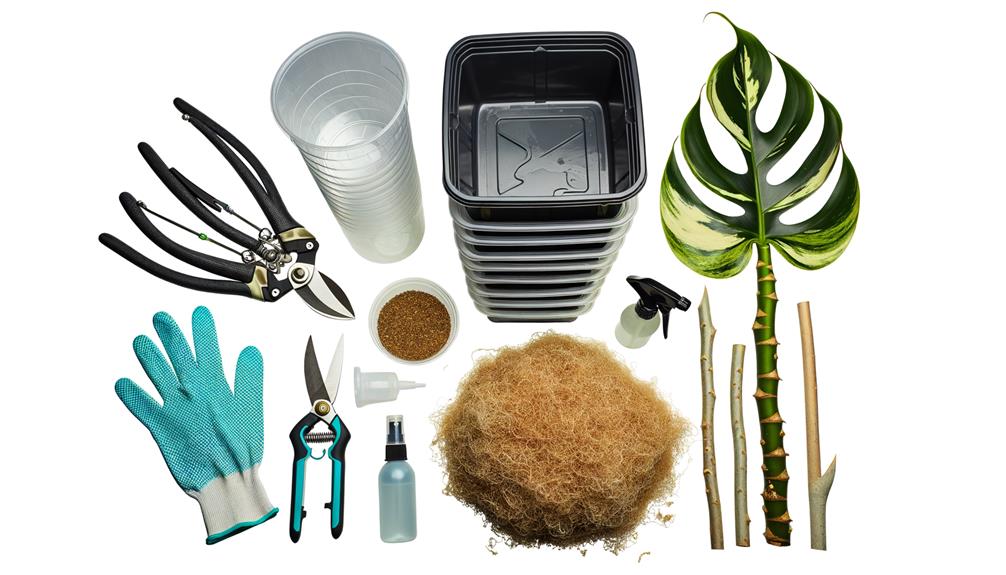
To successfully propagate Monstera Albo wet sticks, gather a sharp, sterilized blade, rooting enhancer, a clean container, well-draining soil mix, and distilled water. Each tool plays a critical role in guaranteeing proper propagation and minimizing the risk of infection.
Here's what you'll need:
- Sharp, sterilized blade: Essential for making clean cuts, reducing damage to plant tissue.
- Rooting enhancer: Promotes faster root development and increases the success rate.
- Clean container: Prevents contamination and provides a sterile environment for rooting.
- Well-draining soil mix: Ensures proper aeration and moisture retention, crucial for root growth.
Using these specific tools and materials optimizes the chances of successful propagation, ensuring your Monstera Albo wet sticks thrive.
Preparing the Cutting
To guarantee successful propagation, you need to select a healthy node with at least one aerial root.
Use sharp, sterile cutting tools to make a precise cut just below the node.
Don't forget to sterilize all equipment with rubbing alcohol to prevent infection.
Selecting Healthy Node
When preparing your Monstera Albo cutting, make sure you're selecting a healthy node that includes at least one aerial root and a visible growth point to maximize propagation success. The node is an essential part of the plant's anatomy, acting as a focal point for growth. To guarantee you choose the best node, follow these guidelines:
- Inspect for Aerial Roots: Look for nodes with well-developed aerial roots, as they assist in water absorption and stability.
- Identify Growth Points: Guarantee the node has a visible growth point, usually a small bump or emerging leaf.
- Check for Health: Avoid nodes showing signs of disease, discoloration, or damage.
- Select Mature Nodes: Opt for nodes from mature, healthy stems to increase the likelihood of successful propagation.
Proper Cutting Tools
For preparing your Monstera Albo cutting, make sure you use sterilized, sharp cutting tools to prevent infection and make clean cuts. High-grade gardening shears or a precision knife are ideal. Dull blades can crush plant tissue, impairing its ability to root and making it susceptible to pathogens.
When selecting your tool, consider blade material; stainless steel is highly recommended for its resistance to rust and ease of sterilization. Guarantee the blade's edge is finely honed to facilitate a smooth, swift incision through the stem.
Additionally, employing a clean cutting board to support the plant segment during the cut can enhance precision and prevent contamination. Proper cutting tools are essential for successful propagation and plant health.
Sterilizing Equipment
Checking your cutting tools are properly sterilized is crucial to prevent the introduction of pathogens that can compromise the health of your Monstera Albo cutting. Follow these steps to make sure your tools are clean and safe:
- Clean the Tools: Remove any dirt or plant residue from your scissors or knife using soap and water.
- Disinfect: Immerse the tools in a solution of 70% isopropyl alcohol or a 10% bleach solution for 5-10 minutes.
- Rinse: Thoroughly rinse the tools with distilled water to eliminate any remaining disinfectant.
- Dry: Use a clean, lint-free cloth to dry the tools completely before use.
Creating the Right Environment
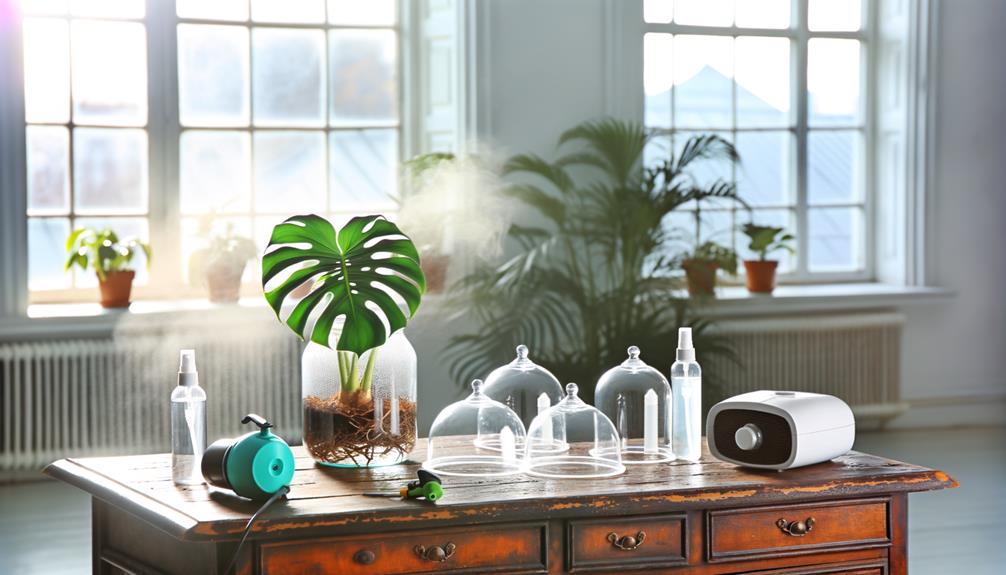
Achieving successful Monstera Albo wet stick propagation necessitates meticulous control of humidity, temperature, and light conditions. You must replicate the plant's natural tropical environment to foster growth. Aim for a consistent temperature between 70-80°F (21-27°C). Guarantee bright, indirect light to avoid leaf scorching. Utilize grow lights if natural light is insufficient. Humidity levels should be maintained at 60-80%.
| Environment Factor | Ideal Condition |
|---|---|
| Temperature | 70-80°F (21-27°C) |
| Light | Bright, indirect light |
| Humidity | 60-80% |
| Air Circulation | Moderate, avoid stagnation |
| Substrate | Well-draining, moist soil |
Maintain moderate air circulation to prevent mold. Use a well-draining substrate to avoid waterlogging. By regulating these parameters, you'll maximize the chances of thriving Monstera Albo propagations.
Moisture and Humidity Tips
Maintaining ideal moisture and humidity levels is crucial for the successful propagation of Monstera Albo wet sticks. You need to make sure that the environment mimics the plant's natural tropical habitat.
Here's how:
- Humidity Levels: Aim for 60-80% humidity. Use a hygrometer to monitor accurately.
- Watering: Keep the medium consistently moist but not waterlogged. Over-watering can cause rot.
- Misting: Regular misting helps maintain surface moisture but shouldn't replace adequate watering.
- Humidity Trays: Place a humidity tray with pebbles and water under the container to increase ambient humidity.
These steps help the wet sticks remain hydrated and promote ideal root development. Remember, consistent moisture and high humidity are crucial for successful propagation.
Light Requirements
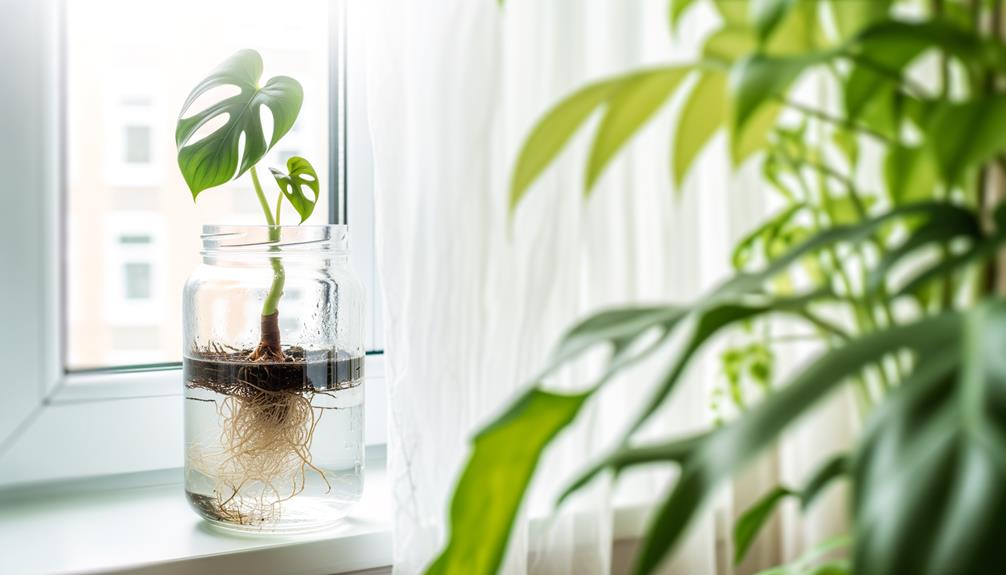
Light plays a critical role in the successful propagation of Monstera Albo wet sticks, requiring bright, indirect sunlight to promote healthy growth. Position the wet stick in an area where it receives filtered light for 6-8 hours daily.
Direct sunlight can cause leaf burn due to intense UV radiation, so avoid placing it in full sun. Artificial grow lights can supplement natural light, especially in low-light environments. LEDs with a spectrum range of 400-700 nm are ideal.
Light intensity, measured in foot-candles, should range between 1000-2000 for best photosynthetic activity. Insufficient light can slow down growth and hinder chlorophyll production. Monitor light levels regularly to ensure your Monstera Albo receives the necessary energy for robust development.
Encouraging Root Growth
To stimulate strong root development in Monstera Albo wet sticks, provide sufficient hydration and ideal substrate conditions. Enhance the substrate remains moist but not waterlogged, using a well-draining medium.
You can follow these steps to encourage root growth:
- Humidity: Maintain high humidity levels, ideally around 70-80%. This creates a conducive environment for root formation.
- Temperature: Keep the temperature between 75-85°F to accelerate metabolic processes and root development.
- Substrate: Utilize a mix of sphagnum moss and perlite to guarantee both aeration and moisture retention.
- Hormones: Apply a rooting hormone to the cut ends of the wet sticks to promote faster and more robust root growth.
These practices will greatly enhance the likelihood of successful propagation.
Monitoring Progress
Regularly inspect the Monstera Albo wet sticks for signs of root development and overall health to guarantee successful propagation. Examine the roots for white, firm, and elongating structures, indicating healthy growth. Monitor the nodes for any signs of rot or decay; blackened or mushy areas suggest a problem.
Maintain ideal humidity levels around 80%, and ensure indirect light conditions, as these factors are essential for promoting root formation. Check the moisture content of your propagation medium, keeping it consistently damp but not waterlogged. If you notice any fungal growth or mold, gently clean the affected areas with a diluted hydrogen peroxide solution.
Regular monitoring helps you catch issues early, promoting strong and healthy Monstera Albo plants.
Transplanting to Soil
Transplanting your Monstera Albo wet sticks to soil involves carefully preparing a well-draining mix to support robust root development and guarantee overall plant health. Here's a step-by-step guide:
- Soil Mix Preparation: Combine equal parts of peat moss, perlite, and orchid bark to create a well-aerated, moisture-retentive medium.
- Pot Selection: Choose a pot with drainage holes to prevent waterlogging, which can cause root rot.
- Planting: Place the rooted wet stick into the soil mix, ensuring the node is just above soil level to promote aerial root growth.
- Watering: Water thoroughly after transplanting, then allow the top inch of soil to dry out between waterings to maintain ideal moisture levels.
Troubleshooting Common Issues
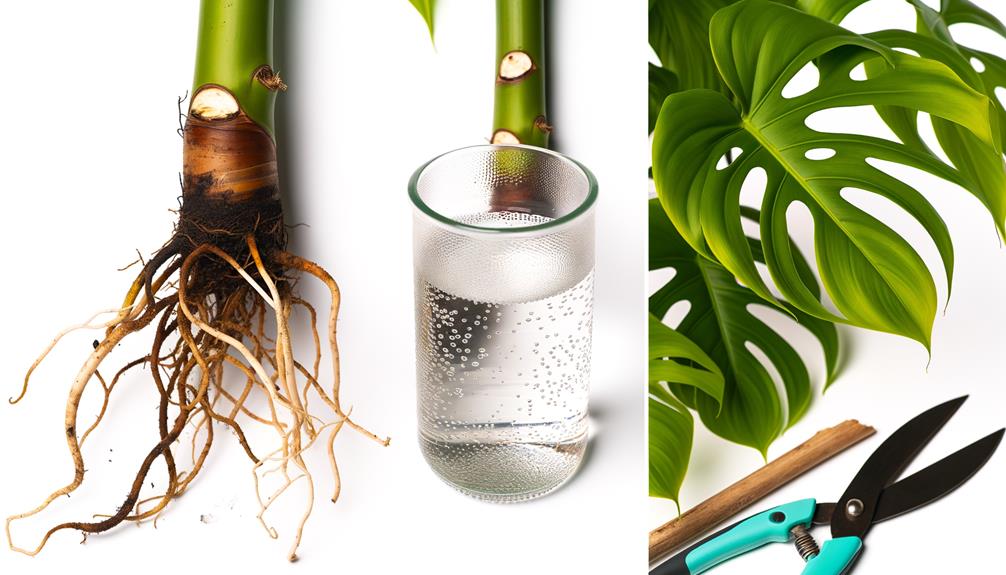
When propagating Monstera Albo wet sticks, you might encounter issues such as slow root development, yellowing leaves, or mold growth, each requiring specific troubleshooting steps.
For slow root development, make sure your medium remains moist but not waterlogged, and consider using a rooting hormone to stimulate growth.
Yellowing leaves often indicate overwatering or nutrient deficiency; check your watering schedule and supplement with a balanced fertilizer.
Mold growth typically results from excess moisture and poor air circulation. Address this by increasing ventilation and using a fungicide if necessary.
Regularly inspect your propagating environment and adjust conditions to maintain ideal humidity and light levels. These steps will improve the chances of successful Monstera Albo propagation.
Conclusion
To sum up, effectively spreading monstera albo wet sticks requires diligence, commitment, and meticulous focus. By choosing top-notch cuttings, creating an ideal setting, and closely monitoring growth, you'll secure robust, impressive seedlings.
Stay resolute in identifying stress indicators, promptly addressing problems, and smoothly shifting to soil. Your systematic expertise will materialize in a splendid, mature monstera.
Keep nurturing with attention, and you'll unquestionably revel in the unique, ornamental leaves of your flourishing plant.


